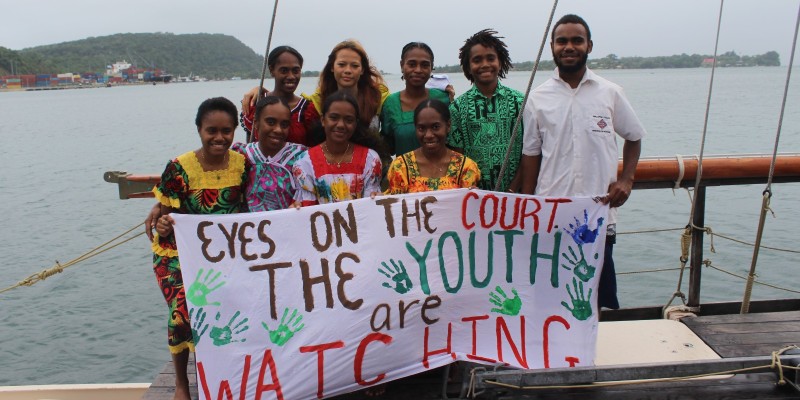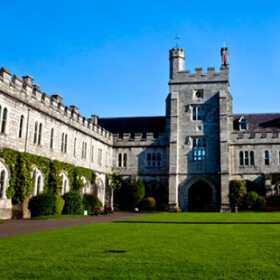Blog
The ICJ Advisory Opinion: A Historical Moment for the Climate and Children's Rights

On Wednesday 23 July 2025, the International Court of Justice delivered its long-awaited Advisory Opinion on climate justice and specifically recognised that climate change threatens children's right to life, right to health and a healthy environment and the right to non-discrimination.
In 2023, the UN General Assembly – the meeting of all 193 countries (member States) which belong to the United Nations – asked the International Court of Justice (ICJ) to give an opinion on countries’ obligations for addressing the climate crisis under international law. The ICJ is the world’s highest court and through the release of an advisory opinion (AO), it can set out legal duties and systems of accountability to ensure all countries are acting responsibly and cooperatively—in this case, taking steps towards curbing greenhouse gas emissions and ensuring the health and stability of the climate.
This initiative was largely led by the Government of Vanuatu, a small island developing state (SIDS) that has been suffering the consequences sea-level rise, ocean acidification, coastal erosion and worsening extreme weather events—especially since Cyclone Pam which hit the island in 2015. They led a global coalition of 132 states who co-sponsored the proposal for a UN General Assembly Resolution calling for an advisory opinion from the ICJ, but the initiative itself came from the Pacific Islands Students Fighting Climate Change (PISFCC), a coalition formed in 2019 by a group of 27 students from the University of the South Pacific who campaigned to convince their government to take up the fight.
As a result of the work of these and other young people all over the world, the advisory opinion is a breakthrough success, not only for climate justice, but for children’s rights. The two questions the ICJ set out to address were:
- What are the duties of states in relation to climate change? / What does international law require governments to do about climate change?
- What are the legal consequences when states do not fulfil their duties? / What can happen to countries/governments who do not follow the rules?
On 23 July 2025, young and old all around the world tuned into the livestreaming of the hearing at The Hague, Netherlands (recording can be found here) to eagerly find out what the ICJ would announce in its long-awaited landmark advisory opinion. Citing many sources and treaties under international law (UNFCCC, Kyoto Agreement, human rights law, UNCLOS, etc.), the Court ruled that all States have a responsibility to prevent significant harm to the environment – which includes the climate system – even if they are not party to the Paris Agreement, or other climate conventions. They also have the legal duty to co-operate with other states to achieve this goal. The Court emphasised the importance of human rights, and especially children’s rights, in the interpretation process which led to this finding. This is a potentially game-changing ruling which will further support the many children and youth who have been litigating in local, regional and international courts in recent years with the aim of holding both State and non-State actors accountable for their failure to protect both human rights and the environment.
In particular, the ICJ cited 3 articles from the UN Convention on the Rights of the Child (CRC) and affirms that climate change threatens children’s right to life (CRC article 6), their right to health and a healthy environment (CRC article 24), and the right to non-discrimination (CRC article 2). The direct mention of these 3 articles from the CRC in their advisory opinion provides the clarification for States that under international law, they have the obligation to ensure children’s rights are protected in the face of the climate crisis. What is especially monumental is that recognising that climate change threatens article 2 the right to non-discrimination confirms that States must provide equal protection to all children, everywhere.
The ICJ also made it clear that intergenerational equity is one of the key principles which must be considered when deciding on the duties of States in respect of climate change. In fact, all human rights are important for this; however, the Court made specific mentions of the CRC. This is good news for children because it means they can rely on this child rights-positive interpretation when they present their own climate cases to courts. To do you so, children and their lawyers can use this useful summary of the child rights related legal arguments that came up in the Court’s opinion but also in the submissions that States, and other stakeholders made to the court, on our caselaw database.
While this landmark advisory opinion by the ICJ is a huge win for climate justice and has the potential to strengthen and set a clearer framework for future legal action on the climate, here at the Youth Climate Justice project we celebrate the children and young people around the world who have been at the forefront of pushing for stronger environmental protection and ensuring that everyone is doing their part to create a world that is just, safe, and healthy—for not only humans, but for every living and non-living part of nature from endangered species and polluted rivers to the Ocean and Amazon rainforest. On 23 July, the courtroom in The Hague was filled with adults, but it is the children and youth who have been officially behind the scenes, and, in truth, they were the drivers.
In the article ‘Whether you win or lose, some fights are worth fighting’: The largest ever climate case’s unlikely origins by Isabella Kaminski’, Cynthia Houniuhi, one of the Pacific Island students behind this global initiative, shares her story of noticing changes on the island she calls home and how this motivated her and a small group of students to approach the world’s highest court with their request for an advisory opinion. The PISFCC youth rallied with the ever-growing youth climate justice movement and built a network with other young climate activists which led to the establishment of the youth-led organisation World’s Youth for Climate Justice (WYCJ). After years of campaigning, what started as small group of students led to 132 countries agreeing to co-sponsor their application to put a resolution before the UN General Assembly back in 2023 (Kaminski, 2025). Now, it is clear: taking climate action is no longer optional, but a legal obligation.
The Witness Stand for Climate Justice, another initiative by the PISFCC youth, is great place to listen and learn about the experiences of affected people across the globe, and where you can also share your story. Through sharing stories and connecting with others, it has largely been the accumulation of each and every small and big act of children and young people in Vanuatu and beyond that has caused a powerful butterfly effect leading to this massive victory for people and the planet.
Written by PhD researchers Liesl Muller and Emily Margaret Murray.

